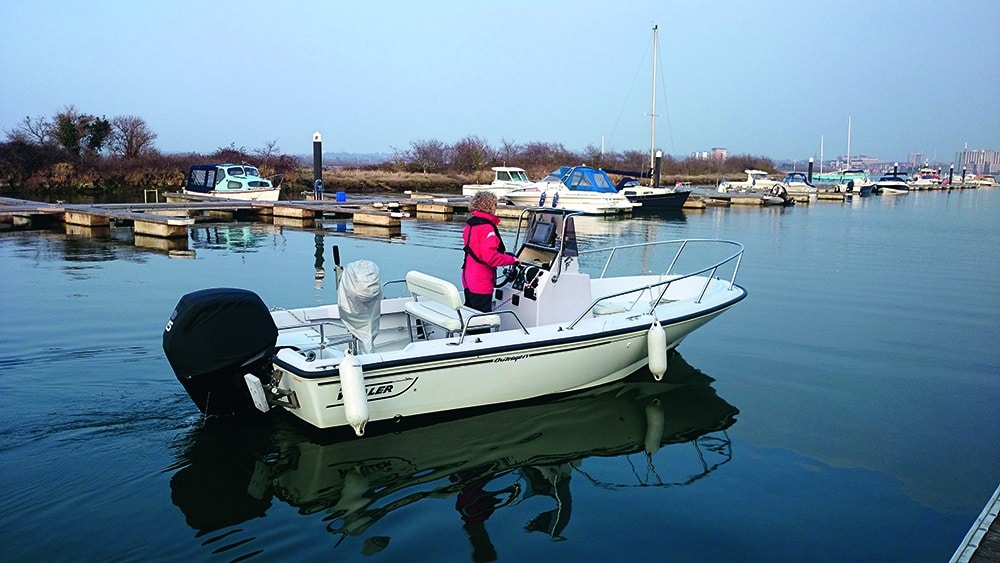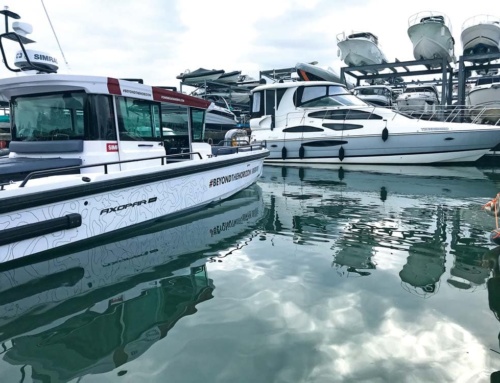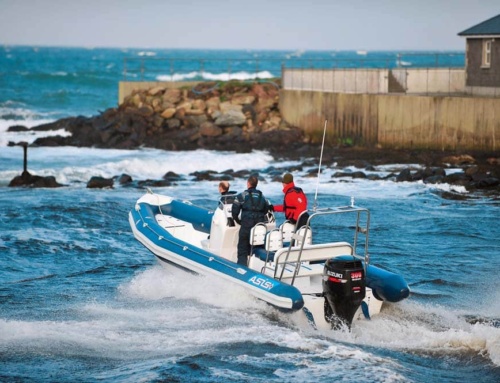Putting a powerboat alongside a pontoon, dock wall or jetty can be a really stressful experience and can spoil a fun day on the water. Being good at it, though, is hugely satisfying and makes boating a whole lot more enjoyable. In this article we’ll give you some hints, tips and tricks to make things a bit easier.
In the previous article we looked at developing our understanding of how wind and stream (tide/current) affect your boat and we looked at the basic building blocks of handling a powerboat. Understanding these basics allows you to take these skills and apply them in a marina situation. Only by understanding these principles of handling in close-quarter situations and then putting in loads and loads of practice will you become really good.
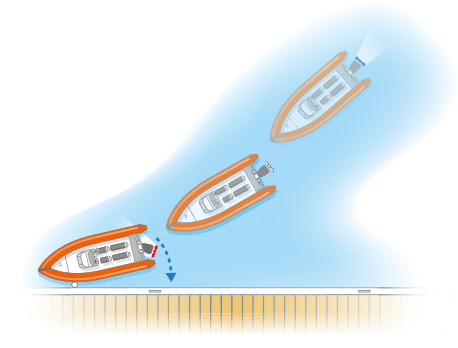 Let’s start off by looking at coming alongside long, straight pontoons, dock walls or jetties.
Let’s start off by looking at coming alongside long, straight pontoons, dock walls or jetties.
It is crucial to identify a good start position. Move to a position about six boat lengths from the section on the pontoon you are aiming at. Ideally, if you can approach into wind and stream then do so, but this won’t always be possible. Aim for an approach angle of about 30°. Then use in gear/neutral alternatively to get some momentum towards the pontoon. Have enough momentum to overcome the wind/stream but don’t go faster than you need to. When a metre off the pontoon, at Powerboat Level 2 we teach: i) neutral; ii) turn wheel rapidly and fully towards the pontoon; iii) go astern briefly (1/2 to 1 second) to arrest forward movement and pull the stern into the pontoon. (We call this ‘steer then gear’.) You may need to engage reverse a few times very briefly to fully arrest forward movement and pull the stern in.
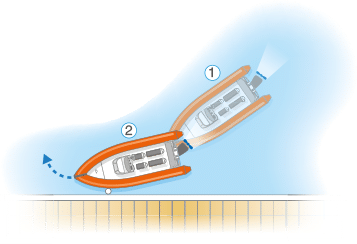 One of the common mistakes made is to have too much momentum when getting to the pontoon and so bouncing off it. The trick is to imagine the pontoon a metre out from where it really is and target that – this forces you to engage reverse earlier. If you time it right, you’ll arrest the forward movement, get parallel with the pontoon and gently slide sideways to come alongside it. Even if you get it wrong and slow too early, it’s better to be a bit short rather than ramming the pontoon and potentially damaging the boat.
One of the common mistakes made is to have too much momentum when getting to the pontoon and so bouncing off it. The trick is to imagine the pontoon a metre out from where it really is and target that – this forces you to engage reverse earlier. If you time it right, you’ll arrest the forward movement, get parallel with the pontoon and gently slide sideways to come alongside it. Even if you get it wrong and slow too early, it’s better to be a bit short rather than ramming the pontoon and potentially damaging the boat.
If turning the wheel towards the pontoon and going into reverse is one option, then the other is to turn away and go ahead. This tends to be the best option when you need to approach from about 70° or so. From your start position, approach slowly by going into forward/neutral etc. Go to neutral. Usually about a boat length away from the pontoon turn fully away from it. Engage forward for 1/2 to 1 second a couple of times. This pushes the stern towards the pontoon and gets the boat parallel to it. Straighten the wheel and go astern a couple of times. This arrests the forward movement and just leaves sideways slide so you gently slide alongside the pontoon.
Once you master these two methods, you should be able to deal with most coming-alongside situations. Often when you come alongside you’ll use a combination of techniques, so understanding how they break into their component parts is key.
As you progress to finger berths, it’s really important to be able to ‘read’ the berths so you can work out a good plan.
Let’s look at some examples:
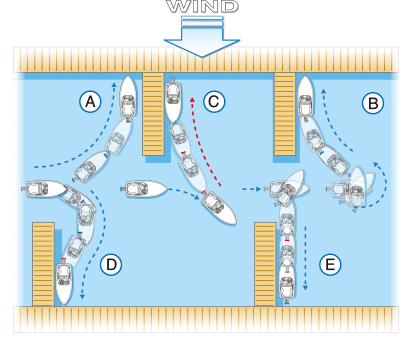
In example A, the berth is ‘open face’. This means that we can see all of it and on turning into the berth our momentum should carry us onto the pontoon. The trick with A is stopping, turning, then approaching at about 30°. Be careful to focus on the middle part of the pontoon as if you focus too much on the end you risk wrapping yourself around it.
In contrast, B is ‘closed face’ as we approach it. Going past and turning using the ‘turn in a confined space’ technique we addressed in the last article sets you up for a similar approach to A.
C obviously requires a reverse in. How easy this is will depend hugely on the wind. In this example it is from the top of the page and the craft is reversing into the berth, so it should be fairly straightforward as the vessel is very stable reversing into the wind. If the wind is from the bottom of the page, this could be really very challenging as the wind will be trying to rotate the bow downwind so the craft lies side on to the wind. Try to keep the bow pointing straight into the wind and/or use a bow thruster to tidy up the bow position.
With D the example shows the decision to drive straight into the berth. Care needs to be exercised so as not to have momentum into the adjacent berth. Again, wind direction may play a key part, so with the knowledge you have about how it affects the craft, factor this into the approach.
E shows a straight reverse in. Whether you choose a straight reverse or an approach that gives some momentum onto the berth will again depend on the wind direction.
Rather conveniently, in all of these manoeuvres we’ve ignored the effects of any stream and the wind has always gone up or down the page. Clearly life isn’t really like that, but the trick with any of these manoeuvres is to step back and think it through before piling in. Don’t forget: ‘Assess, Plan, Execute’. Understand the way your boat reacts to wind and stream, look at the direction of these and then predict what will happen to your craft. Then create a plan to approach the berth, factoring these forces into things. Never forget to always have an escape route.
Remember, though, no article or training course ever replaces time at the helm, so get out there and practise, practise and practise some more.
In the next article we’ll look at leaving berths and using lines to help you.
Have fun!
Top tip:
As you get better at coming alongside, a good trick is rather than turning towards the pontoon then going astern, do it as one movement and go astern and turn towards the pontoon as one. This can make your coming alongside smoother.

